Pirate metrics: how to create an email campaign based on the AARRR principle. Part 3

On Pechkin's blog on Habré, we write a lot about interesting techniques for working with email newsletters . Earlier, we considered common mistakes when creating forms in mail letters, and today we bring to your attention an adapted translation of the note from the Sendwithus service team about which approaches to the development of letters help to increase their conversion. The first part of the material can be read here , and the second - here .
Stage of retention (and return of users) and trigger sending
Deduction is a metric closely related to the concepts of income and growth in the “pirated” model. Hold (customer loyalty) is the number of customers who return and use your product again and again.
In this chapter, we will look at things that keep customers and encourage them to continue using your product for a long time. We will tell you about tools for developing customer retention strategies with examples — they [tools] will be your best marketing channel to help you increase customer lifetime value (LTV = lifetime value).
')
These retention strategies are based on the use of transactional letters, i.e., targeted trigger letters, each of which is sent in response to a specific target action taken. Trigger letters are especially effective at the stage of retention, because they help to solve various problems of users passing through the sales funnel.
Later in this chapter, we will look at specific customer retention and return strategies, but first let's see what we are talking about and how to measure it.
"Better a bird in the hand than a crane in the sky"
It is always easier to keep existing customers than to find new ones.
Users who have reached the hold phase (according to the “pirated” model) become extremely important to you, and you should take care of them. These customers are already using your product, they understand the value proposition and are just a step away from the stage when they just have to pay you. According to a study by the Harvard Business School, it was found that an increase in the number of users retained by only 5% leads to an increase in profits of 25-95%.
How to determine which user is worth holding
A “retained” user is much more than just a customer who has been using your product for a long time. A client who regularly pays for your service, but never enters his account - not an “ideal” client, not the one you need, so it is important to determine the characteristics of a “good” client.
Like "activated" users (read about user activation in the previous part of the translation - approx. Transl.), Retained users are customers who use your product because of some features that distinguish it from competing products. By evaluating a retained user using such metrics as subscription availability, use of certain functions, involvement or activity, you can make sure that customers meet your company's expectations and what you produce is in real demand.
Determine the main behavioral triggers
Once you have figured out what characteristics a retained user should have, you need to determine his behavioral triggers. This is a turning point, like a sudden insight for your users, when they suddenly realize the value of your product and are now ready to use it for a long time.
For example, Facebook: the creators decided that their main behavioral trigger will be the moment when the user adds at least 15 friends. In his lecture for the Startup Class, Alex Schulz (Alex Schultz) explains that if a Facebook user has at least 15 friends, then most likely he will use the service for a long time, so their retention strategies are aimed at finding and adding friends.
To determine your own behavioral triggers, think about actions that are specific to your ideal users, then develop a retention strategy based on this trigger action.
How to measure retention
Before you dive into creating a retention strategy, you will need raw data to gauge success.
Retention is measured in percent of customers who continue to use your product for a long time. Below is a simple formula for calculating retention:
= ((CE – CN) / CS) x 100%- CE = Number of customers at the end of the period (customers at the end of a period)
- CN = Number of customers for new customers who have emerged over the period (new customers)
- CS = Number of customers at the beginning of the period (customers at the start of a period)
Obviously, your goal is to have a high retention rate (because losing customers is not cool), but the point of counting is to evaluate progress over the period.
Another way to measure retention is to calculate customer churn.
What is customer churn?
Your customer churn is the number of users who stopped interacting with you during the selected period. Like withholding, customer outflow is calculated as the ratio of the number of all lost customers to the number of customers at the beginning of the month (or any other period of your choice)
3 / 100 = 3%
Not so important is the method of calculating customer retention, it is important consistency in the methods of calculation.
Three ways to increase customer retention
Preparing customers for retention begins long before they reach this stage in a “pirated” model. In fact, preparation begins with the first stage of the sales funnel. Customers do not immediately recognize your product, so building relationships that you should keep will take time.
Below are three ways to help set yourself up for success:
- Find the right user . Believe it or not, retention begins at the point of attraction. If you attract the right users, they naturally derive maximum benefit from your value proposition. If your retention rate is low, you are probably attracting “wrong” users. Determine the characteristics of the ideal user for you and use their characteristics to assess the quality of your stage of attraction.
- Come up with an incredible onboarding strategy . Make sure that your new customers use your product - this will help you in the retention phase of the “pirated” funnel. Are your users activated? Do they know about the advantages of your product (over competitors' products)? Do they use them? If not, it will be difficult using letters to convince users to stay true to your product. Retention strategies add value to your product (this is an extra bonus!), However, if customers miss the core value of the product, it means that you cannot do it with a bonus.
- Do not let customers forget about you . The best retention strategies continue to solve the problems of their customers for a long time after they start using the product. By engaging users in a process of ongoing and ongoing learning in the form of video tutorials, webinars, slideshows, e-books, blog posts, and other things, you can make sure that your customers don't forget about you. However, remember: you need to send your users actual content that has practical value. Customers who find value in your letters will repay you with loyalty to the product.
Seven working retention strategies in letters
In the conditions of abundance of various products on the market, it becomes more difficult to keep the interest of customers. So, in case you find that your customers leave the funnel after completing the activation phase, we have compiled seven strategies for sending trigger letters to help you return customers.
1. Notifications
“A notification letter is the most effective letter you can send,” Alex Schultz.
Notifications are a great tool for returning customers, especially for public products. Such letters stand out among all other clients in incoming mail, because the content of the letter reflects directly what happens to their accounts. After the welcome letters, the notification letters receive the largest percentage of open-rate in comparison with other types of letters.

Like push notifications (notifications without a request), notification letters are letters sent in real time in response to any user action. They are sent when the user has a new friend or subscriber, when someone writes a message to him or comments on his post, or in any other user action with the product. These notifications are important to the user, and with their help, you can return the customer's interest in the product and keep it.
There is another reason why notifications can become a successful retention strategy - you can play on user ego. In social networks, such notifications are used as a way to retain users for a long time.
Twitter letter about “new subscriber” - so-called “good news”
In the early stages of Twitter, Josh Elman, the former head of service development, realized that "as soon as a potential client signs up for updates from 30 people, he becomes a lifelong user of the service, more or less active."
Trigger notifications are sent for several reasons. They are sent when the user has a new friend or subscriber, when someone wrote him a message or commented on his post, or in any other user action with the product. These notifications are important to the user, and with their help, you can return the customer's interest in the product and keep it.
Immediately after someone subscribes to your updates, Twitter sends you a notification (as in the image below), informing you of a new subscriber.

This notification has four objectives:
- Reminds the user of Twitter
- Allows the user to subscribe to updates from new people.
- Returns a user to interact with Twitter
- Creates a positive user experience, since the letter has “good news”
This is a very simple letter, but targeted. It reflects the behavioral trigger characteristic of Twitter - the ability to easily subscribe to updates for new people and use the service. In addition, there is a thoughtful subtext: the text of the retention letter is regarded as good news. “Congratulations! You have new subscribers! ”
LinkedIn uses a similar strategy to increase customer returns. Their notification “These Users Viewed Your Profile” returns clients to work with LinkedIn and encourages them to view other people's profiles and add new contacts.

Determine the actions of users, after which you will send notifications
Both those and other letters (from Twitter and LinkedIn) are sent to the user to induce him to a specific action: add someone as a friend. The notifications that your company sends should also prompt certain actions. Choosing a specific target action is a difficult moment.
Before choosing a trigger action for creating notifications, you need to determine what users need to do in order to understand and extract value from your product. This is a turning point, similar to enlightenment for your users, thanks to which they “grasp the essence” of your product and begin to use it regularly.
For Twitter, this action is a subscription for 30 people. For Facebook, add 15 friends. Use quantitative metrics that relate to retaining users and encouraging them to take specific targeted actions with the help of your letters.
2. Newsletter
Well, let's face it: the mailing is in most cases very poorly organized. Letters are filled with irrelevant content and are hardly divided into semantic parts - for most users, such letters are boring and useless. However, they are all still sent, so why not make these letters cool?
Divide all your users into segments.
Do not send all the same letters. News (informational) newsletter can not fit everyone (and will not work). Do not do something that is doomed to failure; it is better to divide your users into segments so that they accurately benefit from your newsletter. Over time, this can turn into a separate job, but it is guaranteed to be a good way to retain your target group's customers.
Develop a schedule for your customers
Develop a newsletter schedule for your customers. Make a strict schedule for sending letters and follow it. If you have a schedule, your users will know when to wait for the next letter — this is how you establish a trusting relationship between you and your customers with the help of a sending schedule.
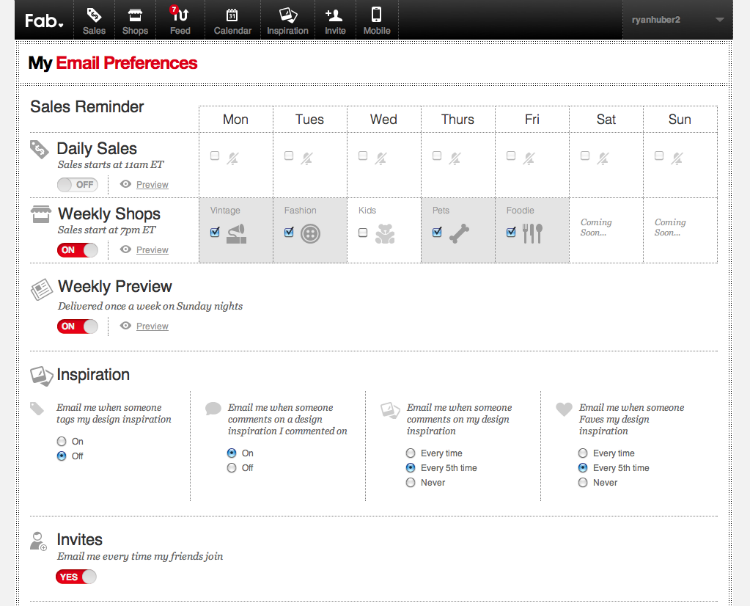
Fab has carefully approached the question of segmentation of its users: it divides customers into segments according to their preferences. Fab allows users to select topics of interest to them and the frequency of receiving newsletters *, and can also show you a preview of a letter that will be sent in a short time.
* And not only that, Fab even stops sending emails that you don’t open.
The golden newsletter rule
Once you have properly divided your users into segments, Hubspot offers you the golden rule for creating a newsletter:
"Your content should contain 90% of valuable information and 10% of promotional offers."
Every day your customers receive dozens (or even hundreds?) Of letters. Most of them are of an advertising nature - click, download, start using, see ...
Do not do this.
You can significantly win against the background of all the advertising junk in the mailboxes of your customers only if you remember that you first need to present the value of your offer.
Do you send your customers up-to-date and useful content from which they can extract value right away?
If not, then they are unlikely to click on the link in the letter. All people are busy - give them the immediate reward they are waiting for.
There is one company that organized the newsletter correctly - I myself look forward to their letters every month.
Death to the Stock Photo is a company that sends cool pictures in letters. Every month a letter from them is sent to my mailbox, in which free copyrighted high-resolution photos are embedded. I open the photos, read the text and scroll through the letter to the end. Each. Time. (To view the full version of the letter, click on the picture)
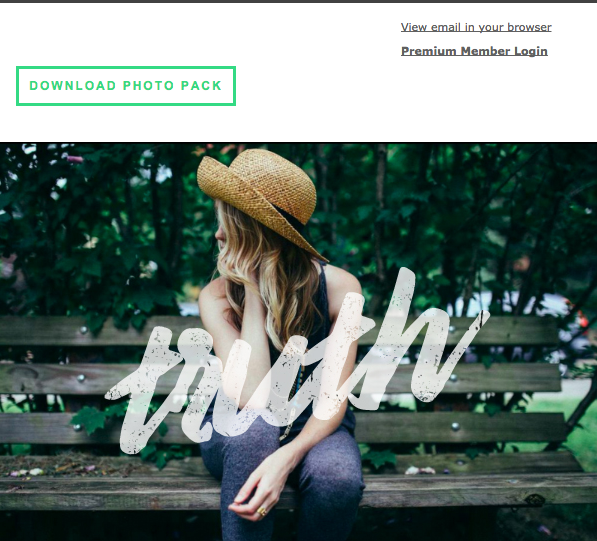
Why is this letter so cool?
Because this is exactly what I subscribed to. It is sent strictly on schedule, so every time I wait for it. It contains 90% of useful information and 10% of advertising at the end.
3. Educational letters
Training letters continue to tell customers about the benefits of your product after the onboarding process.
There are two approaches to writing such letters:
Acquaintance with specific functions (features of your product)
You have probably noticed that in your product there are such underestimated functions that even the actively using customers do not know about. If this is the case, then you can create a series of training letters that would be automatically sent to those users who have not yet tried these functions in action.
Facebook example:
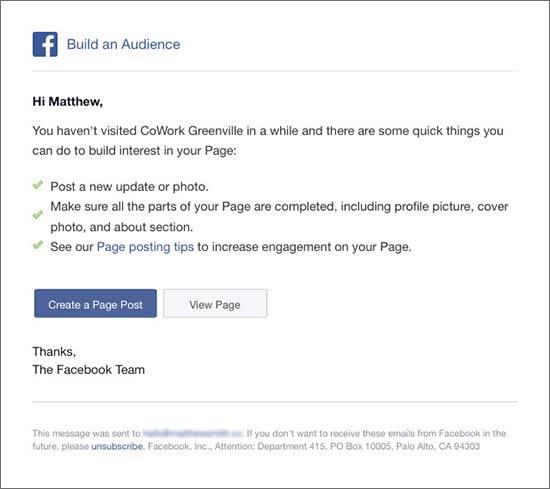
Here, Facebook highlighted a segment of users who did not log in and did not update the information on their “for a while” page. This letter is a polite reminder that your page still exists, it gives a few tips on how to use this or that service function.
Educational content on topics indirectly related to your product.
Educational content does not have to be directly related to your product. Sometimes potential customers understand how to use your product, but they lack some incentive to get started. If this is the case, then you can send your users a lot of valuable information, say, on an indirect topic, that is, not specifically related to your product, but, for example, motivating the user to work more efficiently or more productively. Content marketing falls into this category.
Typecast educational letters give users exclusive access to content that allows them to learn the basics of typography. It is not necessary to have typographic skills to work at Typecast, but sending out will definitely be useful to you if you use this service.
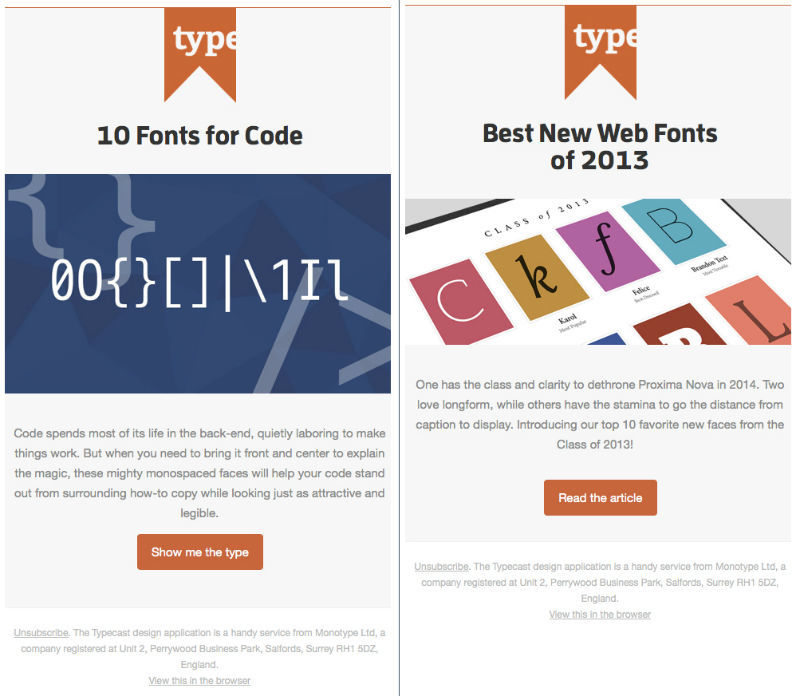
4. Product Updates
Keep users up to date by sending emails about updates to your product.
If you are an IT company (SaaS solutions, building applications ...), then your product is definitely constantly updated. This means that customers who subscribe to you may be waiting for updates and improvements.
There is one way to keep users interested in your product - to keep them informed about how the product is developing and what's new in its updates. Like notification letters, update letters return users to your project using the “good news” strategy, introducing new features and new ways to use the product.
Zapier is constantly changing - the creators add new service integration to the application. Their update letters give me a clear and understandable description of all the new features that I can try.
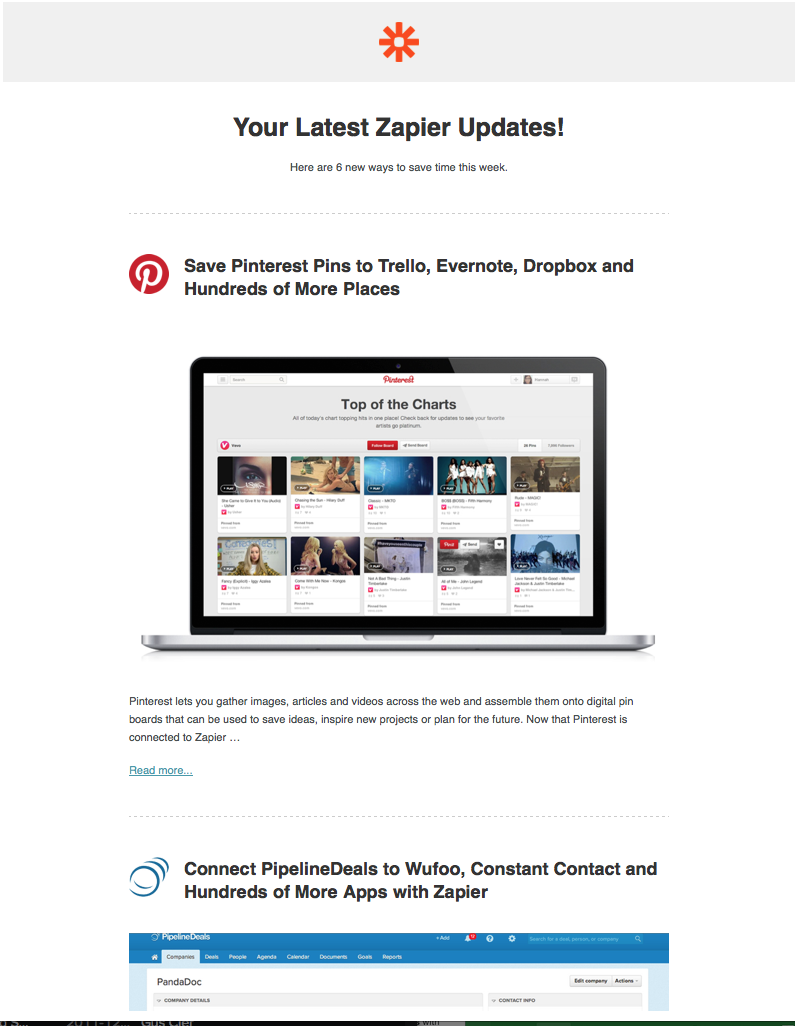
5. Letter to return customers
From time to time it happens that you register with the service, use it a little and then stop for some reason. It happens - people leave. However, they do not go away forever. To return them, use letters to return customers.
Letters to return customers are sent to inactive users to encourage them to use the product again. Sometimes you can achieve this by providing coupons and discounts, sometimes with a simple reminder of the usefulness of your product or service.
Trial extension letter
Letters to return customers often take the form of a letter about the completion of the trial period or about its extension. These letters give customers an incentive to use the product, as well as inspire some sense of urgency, prompting customers to return soon.
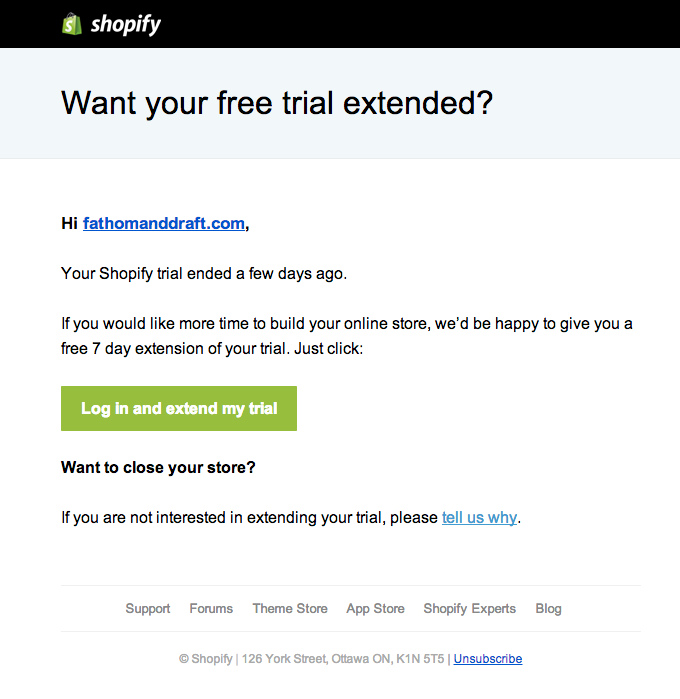
A letter to extend the trial period for using Shopify is a pleasant surprise for those who need a little more time to launch their online store. For Shopify, this letter is also an opportunity to ask users who have left the service, what exactly and why they did not like about Shopify.
Letters of an abandoned basket
Letters of abandoned shopping cart is another example of effective letters for returning customers. Such letters are sent to customers who have already added a product to the basket, but have not completed the order procedure.
According to the Baymard Institute study , 67.45% of all online orders are abandoned. It may not be possible to bring them all to the point of making a purchase, but sending letters about abandoned baskets is still an effective retention tactic.
Salecycle reports that only 50% (approximately) of all sent letters about an abandoned basket are opened. Only half! But even more surprisingly, more than a third of them end up making a purchase on the site.
Just remember - customers drop orders for three main reasons:
- Not satisfied with the price;
- Do not trust the company;
- Do not have an urgent need to buy.
We can do little if the client does not need to buy your product, but you can agree on the price and trust in a letter about an abandoned basket. You can offer coupons and discounts to change the price of the product, and you can show consumer reviews and reviews to increase the level of confidence in you and your product.

Meundies (manufacturers of comfortable underwear) in a letter provided for both situations. They are sure to notify buyers that delivery to the US and Canada is free (price factor), and that it is possible to issue a return of goods without problems (customer confidence factor).
6. Survey letters (consumer loyalty index)
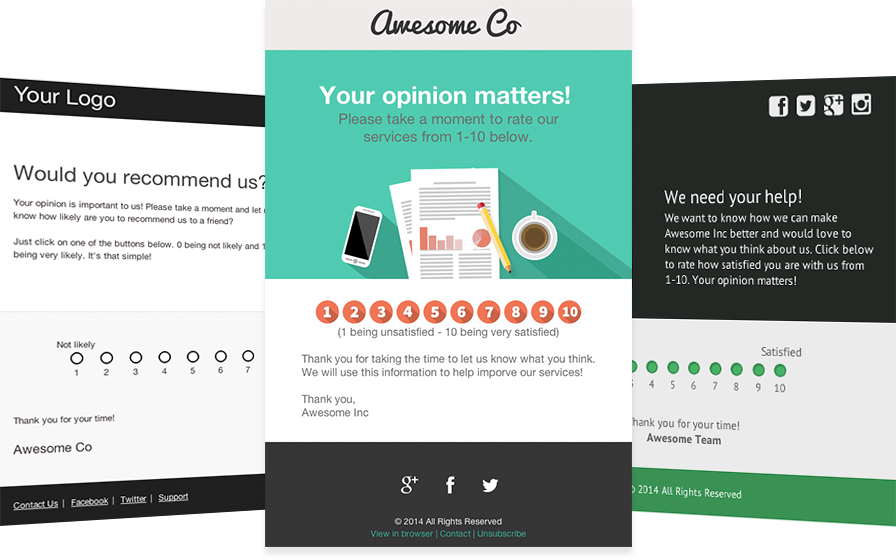
Consumer Loyalty Index (NPS) is one of the best recognized ways to measure customer loyalty. Used to express the lowest cost of retaining current customers and determining the best way to attract new customers. And, to measure NPS, you only need to ask one simple question:
“What is the probability that you will recommend our product to your friends / acquaintances / colleagues?”
One question - that's all. And the NPS calculation itself is very simple:
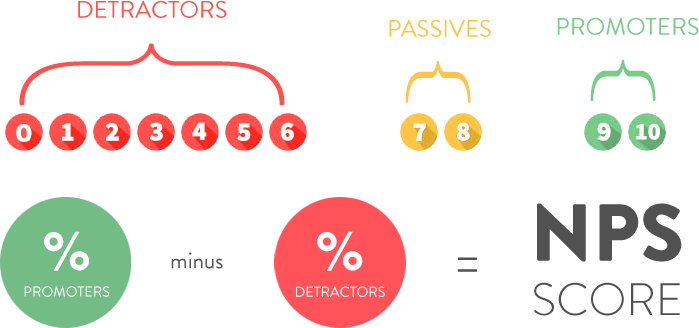
NPS= , ( 9 10), , , ( 0 6),
User loyalty index allows you to:
- Predict how the client will behave in the future;
- Learn directly from customers exactly what they think about your product;
- Stop customer churn.
NPS surveys are sent to users after interacting with the company to get their opinion about your product or service. Send such letters after customers make purchases, send requests to the support service, based on the results of onboarding, and so on. Also, using the survey, you can divide users into segments to keep in touch with loyal customers or to keep customers who may “fall out” from the sales funnel.
7. Reviews
.
Amazon, . , – Amazon, , , , .
, , « », . Great!

Conclusion
:
- .
- .
To start using the retention strategy, first of all you need to find out at what stage customers “drop out” from the sales funnel, then you need to determine the necessary actions to keep them active. Identify custom (quantitative) metrics that relate to active and retained customers, and optimize them.
Send notifications that push the client to commit certain actions, send training and relevant content and letters of updates, thanks to which clients will always be aware of your events
Source: https://habr.com/ru/post/270143/
All Articles